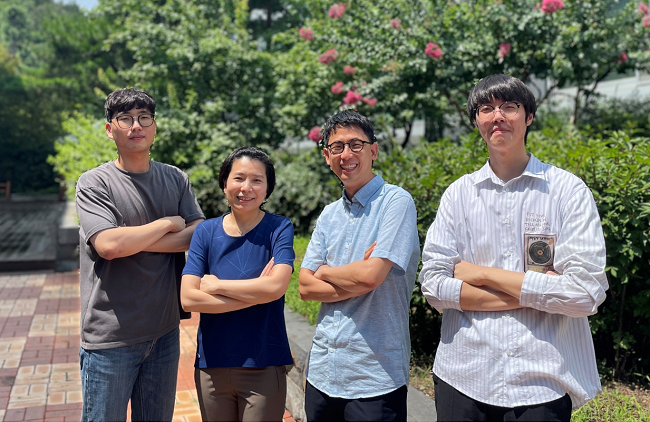Reviewed by Alex SmithAug 13 2021
Along with the increasing demand for electric vehicles, all-solid-state batteries have gained higher attention. All-solid-state batteries are next-generation batteries that would be alternatives for lithium-ion batteries, which are inherently hazardous owing to their explosive nature.
 From left, Jaemin Min, Prof. Moon Jeong Park, Prof. Chang Yun Son, Seungwon Jeong. Image Credit: POSTECH.
From left, Jaemin Min, Prof. Moon Jeong Park, Prof. Chang Yun Son, Seungwon Jeong. Image Credit: POSTECH.
The popularization of electric vehicles is hampered by the low ionic conductivity of solid-state polymer electrolytes or the low chemical stability of solid-state sulfide electrolytes. Scientists from POSTECH created a polymer electrolyte without a “dead zone” — which reduces ion transport — speeding up the commercialization of all-solid-state batteries.
Researchers headed by Professor Moon Jeong Park and PhD candidate Jaemin Min of POSTECH’s Department of Chemistry with Professor Chang Yun Son’s research group from the Division of Advanced Materials Science created a novel block copolymer electrolyte that controls the structure through electrostatic interactions.
This study is garnering attention as it fundamentally resolves the problem of lowered mobility of ions in the dead zone that unavoidably exists in traditional two-dimensional morphologies. The outcomes of his study were published in the Proceedings of the National Academy of Sciences of the United States of America (PNAS), an authoritative journal in the area of energy and chemistry.
A majority of the energy storage devices still use lithium-ion batteries. In a lithium-ion battery, ions are moved by a liquid electrolyte. Even minor damage can leak into the electrolyte resulting in a fire or explosion, and so are considered to be unstable.
To overcome this drawback, an all-solid-state battery employs a solid-state electrolyte. Particularly due to the flexible nature of the polymer, the polyelectrolyte-based all-solid-state battery is stable even in a collision and has minimal risk of fire as it is inflammable. Moreover, when compared to lithium-ion batteries of a similar size and weight, the energy density is 1.5–1.7 times higher and, therefore, lasts longer.
All-solid-state batteries, contrary to lithium-ion batteries, contain only an electrode and an electrolyte without a separator between the positive electrode and the negative electrode. The scientists created a new nanostructured electrolyte by controlling the electrostatic interaction in the polymer electrolyte.
The researchers synthesized a set of polymer electrolytes with various strengths of electrostatic interactions employing advanced synthesis methods and affirmed the nanostructures of these electrolytes by small-angle X-ray scattering (SAXS) profiles.
Furthermore, the scientists in Korea analyzed, for the first time, the distribution of ions within the nanostructures through extensive molecular dynamics simulations. Employing the simulations, the scientists detected the charge distribution at several angstroms (Å) and confirmed whether it was a key to create novel three-dimensional low symmetry morphology.
The research is one of its kind in the regard that the low symmetry morphology has generally been found in bimetallic compound materials — however, unprecedented for the case of polymer electrolytes — and is substantial in that it systematically determined the reason for the creation of these nanostructures through experiments and theoretical calculations.
Moreover, this is the first research that indicates a process for fabricating a solid electrolyte possessing a conductivity of 10 times higher than that of a two-dimensional morphology by controlling the charge distribution at the Å unit level in a polymer electrolyte.
Specifically, the research association between Professor Moon Jeong Park, who holds a world-leading group in polymer electrolytes synthesis, and Professor Chang Yun Son, a specialist in computer simulations, developed great synergy.
The new nanostructure enables a significant enhancement in ionic conductivity compared to the typical two-dimensional structures that have been previously reported,”. “This provides a potential route to accelerating the commercialization of all-solid-state batteries and developing safe batteries.
Moon Jeong Park, Professor, Department of Chemistry, Pohang University of Science and Technology
The research was carried out with support from the Mid-Career Researcher Program, the Creative Materials Discovery Program, the Science Research Center Program, and the Young Researcher Program of the National Research Foundation of Korea.
Journal Reference:
Min, J., et al. (2021) Enhancing ion transport in charged block copolymers by stabilizing low symmetry morphology: Electrostatic control of interfaces. Proceedings of the National Academy of Sciences of the United States of America. doi.org/10.1073/pnas.2107987118.